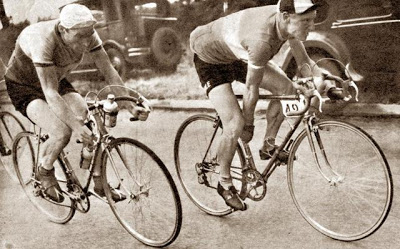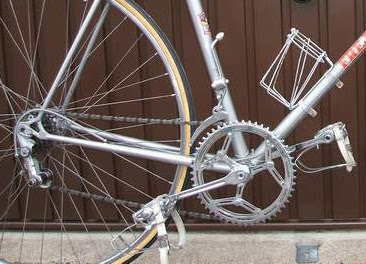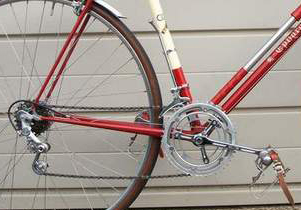Suicide Shifters
 Sun, June 24, 2007
Sun, June 24, 2007 
Suicide shifters is a term I never heard until I came to the US; it is a name given to the lever operated front derailleurs used in the late 1940s and early 1950s.
I came across this rare picture from 1952 of André Darrigade (with Lucien Lauk) reaching down to change chainrings on his Simplex-equipped La Perle bike. When I started racing that same year, I used this same equipment and I can assure you there was nothing “suicide” in their operation.
The most popular lever operated front changer was the French made Simplex, (Above.) which is the one being used by Darrigade in the top picture. It simply pivoted in the center and you pushed the knob on the lever inwards toward the frame to shift up to the big ring, and opposite to shift down. Simplex also made chainrings and bottle cages (both pictured here.) The chainrings were often used with different make cranks like the Italian Gnutti or Magistroni.
Huret, (Above.) another French make, was also popular; I used this one. It worked on a helical, or screw like cam. You pushed the lever forward to go to the small ring, and back to change up.
Huret also had an interesting rear derailleur, it used twin down tube levers and twin cables. (Note: Two cables on the chainstay that also needed a double cable stop.) (The twin levers: Left.) The large lever shifted gears, while the short lever tensioned the chain. On a smooth road, you could run the chain slack for less friction.
(The twin levers: Left.) The large lever shifted gears, while the short lever tensioned the chain. On a smooth road, you could run the chain slack for less friction.
Another front changer I had fist hand experience of was the British made Cyclo-Benilux. (Above.) This one had a twist rod held with two clamps on the seat tube. You twisted the rod to shift up and down. I liked this one because I found I could reach behind my right leg and the knob at the top of the rod would be right where my hand naturally fell. Unlike the other changers that you had to reach between your legs to operate the lever.
None of these changers had return springs, they were manually operated both ways. Most of them had a simple friction device to hold it where you put it. But on most of them if the chain rubbed it would automatically knock the changer yoke out of the way, and no further adjustment was needed.
This equipment was simple, to the point of being crude, but they got the job done. We became used to it, and skilled in its operation. There was nothing “suicide” about it.
There are probably few people in America with actual experience of using these. (I would be interested to hear comments from any.) The 1970s generation probably gave them the name. They look more awkward to use that the actually were.
I can imagine in years to come, the cyclists who grew up with down tube friction shifters will fade away, and the “Brifter”* generation will then dub these suicide shifters.
Top picture from The Wool Jersey.
Other pictures from Classic Lightweights, UK.
Brifters* Combination brake and gear shift levers.
 Dave Moulton | Comments Off |
Dave Moulton | Comments Off | 

















Reader Comments (25)
A few days later, he came by on a new Schwinn World Sport and said he'd traded the bike for it, and the collector had given him some cash on top of the deal! He was happy, and I was happy the bike had gone to someone who'd take proper care of it, given it's age and provenance.
Then there was the guy with the Cinelli equipped with Bivalent hubs, but that's another long story!
http://www.pereiracycles.com/gallery/rando/pages/IMG_4433.php
Smoothest shifting I've ever seen. It was a little awkward at first, but he chain seemed to just magically jump from ring to ring with no scraping or hesitation. When I first saw the bike, I thought the shifting was just a quaint retro feature, but entirely impractical, but it is actually an elegant and well-functioning piece of equipment.
I didn't understand the mechanism until I saw it in person. It's basically a rod on a pivot that's forked on the end, and the forks fit down into a perpendicular rod inside of a thin tube. This allows the cage to move along that axis of the tube.
J
The term "suicide shifter" did indeed come from vintage motorcycles, it was a shifter usually located back and under the riders saddle.
It was so named because one had to take a hand from the bars to shift, theoretically making it easier to lose control and dump the bike.
So after seeing a cyclist making a similar movement to shift his own bike you can see why the term would have been applicable.
I had never seen one before acquiring the bicycle.
It is elegant in it's simplicity and functions extremely well and thus far, I have never met anyone here who has ever used one, much less seen one.
I like it so much I plan to incorporate them into some future bike projects.
KH
http://www.pereiracycles.com/gallery/rando/pages/IMG_4433.php
My brother and I each received a Follis (made in Lyon, I understand the company recently ceased operation). Our uncle gave them to us. As a result, we were the first kids on the block to have 10 speed bikes.
Because I was an unthinking lout as a young person - I probably still am - I let the bike fall apart over the years. In 1975, feeling guilty, I renovated it somewhat, getting rid of the cottered cranks, replacing the seat post, the saddle, and the hubs (I'd already gotten new rims a few years earlier), as well as the rear derailleur.
The frame is now a basic blue - it used to be white.
The frame, handlebars, stem, strange brakes and front derailleur are original.
About ten years ago, I added Super Champion rims (at the instigation of a very old Los Angeles bike mechanic who was from France), which seem in keeping with the bike. Unfortunately, the rims surround a rather bizarre looking set of Phil Wood sealed hubs that I thought looked cool in 1975. I should probably find something more aethetic in keeping with the bike.
I also have, in pieces, the rear Simplex derailleur. The spring is external to the derailleur - it runs along the bottom of the chain stay, attaching to a little hook. Although I have the original box and the directions, in French, I think it might be missing a few pieces.
My Follis had a 52x36 chain set, too large for the Suicide Shifter to handle very easily, especially when going from the small to large chainring. I think my dad asked the shop owner, former Olympian Ed Lynch, to add "alpine gears," because we lived up in the Santa Monica Mountains, in Los Angeles. It would have been better if Ed hadn't done that (and I wish I knew more about Mr. Lynch).
When I changed the cranks in 1975, I went with the Sun Tour brand, and installed 49/45 chainrings. I got 10 distinct gears this way.
Last January, I switched out my racing cogs. I took off the 1975 Huret derailleur, which was new that year when I purchased it. I put on an old Simplex derailleur that can handle the 28t cog which, at my age and ability, I need.
And this week I switched out the 45t chainring for a 39t chainring. Thankfully, the shifting with the Suicide Shifter is smooth in both directions.
I'm about to add a Brooks saddle, and I think some yellow cloth tape I'm going to shellac to match the honey color of the saddle.
I wonder how it was that my "new" Follis came, as late as 1962, with the Suicide Shifter (as did my brother's slightly smaller bike). I'm glad to see the information you've posed, Dave, about this ancient piece of bike equipment and history.
To have a racer groping like that in the middle of a race.
Simplex "suicide" front changer
I used one of these, bent the arm outwards a little, and modified the front of the changing cage by bending both sides inwards and twisting slightly upwards. This made the change more accurate, and I always changed up with the inside of my leg.
In the early 1950's I used one (in competition) with the Campagnolo Paris Roubaix, the change up was OK, but down to the inside ring was tricky, so I changed to a Campagnolo handlebar control front changer, one hand on the H/B control, the other behind me releasing the wheel.
Your excellent picture looks like Gnutti chairings, not Simplex
Suicide ????
For about 6 months in my earlier (poorer) days, I had an old Peugeot with no front mechanism. I reached down with my right hand to pick up the chain from the small to the large chainwheel. A slight twist of my right foot near the top of the pedal stroke would derail the chain from the large to the small chainwheel. My fingers and inside right heel were always black from chain lube and dirt. I'm still alive too - amazing !!! I would have enjoyed having one of those Simplex changers at the time - mainly to keep my hand clean.
It was a little awkward at first, but he chain seemed to just magically jump from ring to ring with no scraping or hesitation. When I first saw the bike, I thought the shifting was just a quaint retro feature, but entirely impractical, but it is actually an elegant and well-functioning piece of equipment.
I'm just so glad I've never tried these shifters. Even if they are not suicidal, I will most likely end up with crashing given how clumsy I am.
British made Cyclo-Benilux seems to be good This equipment was simple, to the point of being crude, but they got the job done. i will use it, because There was nothing “suicide” about it.
Alas, you are correct - I just read a bike review where the author was bemoaning their old Trek with "suicide shifters", which I can only surmise were of the downtube variety. They were probably index shifters. If the second it takes to take a hand off the bar to snick a downtube-mounted shifter is suicidal, I wonder how we managed for so long.
I added a second chainring to my Lincoln Imp a couple of years ago, using a Simplex "wiggle stick", and, with a 4 tooth difference between chainwheels it gives me a perfect half-step system. It works smoothly and easily without having to add a left-hand lever and cabling to the frame. I have a second "wiggle stick" which I may use on another bike in the future. My '53 Schwinn Paramount road bike is also a half-stepper, but with cable operated Campy shifters. The only concession I've made to "modern times" is to equip all of my bikes with SPD pedals!
May the wind be at your back!
Pete Benton
Brick NJ US
Great article here! Last week I rode my 194- Amerio with Campag Cambio Corsa shifting system. That makes direct-lever front derailleurs as you're describing look easy and high-tech. A bike builder local to me--Tony Pereira--has made some Singer/Herse replica front derailleurs with wire cages. Tres chic, tres leger!
I used this Simplex shifter as a young bike racer in Belgium, during the late 1940s. it is interesting to note how much equipment has changed.